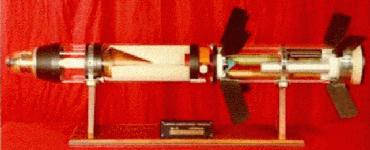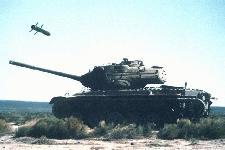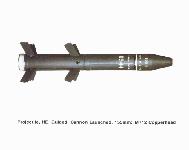Here's a bit more detail about Copperhead and other artillery guided munitions and some pics...
The M712 Copperhead projectile was the first smart artillery round ever developed. Its accuracy is measured in centimeters, and its lethality is impressive. Copperhead is a cannon-launched, 155mm artillery projectile which guides itself to a laser-designated target. The munition is capable of defeating both armor and point targets at ranges of over six kilometers, and provides the battlefield commander with the unparalleled capability of utilizing artillery to the same effect as direct fire weapons and close air support. The system was employed during Operation Desert Storm, during which it met with great success. Copperhead projectiles were used to destroy observation and border guard posts and forward radar installations during the first week of artillery attacks.
The cannon-launched guided projectile (CLGP) M712 (Copperhead) is a 155-mm, separate-loading, laser-guided, HE projectile. It is heavier (137.6 pounds) and longer (54 inches) than the standard 155-mm projectile. The M712 projectile consists of three main sections: a guidance section (forward), warhead section (center), and control section (rear). The guidance section contains the seeker head assembly and the electronics assembly. The nose of the projectile houses a laser seeker in a plastic cone. The warhead section contains an HE antitank warhead consisting of 14.75 pounds of composition B. The control section includes the fins and wings that deploy in flight and allow the round limited maneuverability.
The trajectory of the Copperhead projectile is similar to that of a conventional round. Only when the projectile reaches a point on the descending branch of the trajectory does it differ. At that point, on the basis of the two-digit timer setting included in the fire commands, the guidance and control systems are activated. This enables the projectile to alter the remainder of its trajectory.
At 20 seconds from impact, the laser designator operator begins designating the target. The ground laser operator may use a G/VLLD, a laser target designator (LTD), or modular universal laser equipment (MULE). Airborne systems include the AH-64, OH-58D, and unmanned aerial vehicles. The Copperhead projectile acquires the reflected laser energy and initiates internal guidance and control, allowing it to maneuver to the target.
The ground surface area in which the round can maneuver is limited. The optimum limits of maneuverability of the Copperhead round is called a footprint. The size of the footprint is determined by the range and the shape of the trajectory, but it can also be affected by cloud height. The ballistic aimpoint is usually short of the target location sent by the laser designator operator. The distance that the ballistic aimpoint is short of the target location varies and is called the offset correction. This offset distance is used to ensure that the maximum probability of hit occurs at the original target location sent by the observer. The larger the target location error, the lower the probability of hitting the target.



Picatinny has been at the forefront of Smart Munitions development since the beginning. They have advanced from laser-designated weapons to those using infrared (IR) and Global Positioning Systems (GPS) and seeker technology to become the recognized leader in smart ammunition.
The first development in smart munitions was the Copperhead, a 155mm, indirect fire weapon that gave artillery a new long range capability to destroy tanks, self-propelled artillery, air defense vehicles, armored personnel carriers and other hard point targets. The Army initiated Copperhead development in 1971 and it was fielded in 1982. Copperhead, officially named the M172 Cannon-Launched Guided Projectile (CLGP), gave artillery the capability to kill a moving or stationary armored target with one or two rounds using pinpoint accuracy. It homes on reflected laser energy and delivers a devastating shaped charge warhead for one-shot target destruction using established communications methods and requiring less overall logistical support. As the world's first smart, guided artillery round, Copperhead is no longer in production but serves as a valuable benchmark for precision-guided mortar munitions.
Examples of Smart Munitions Being Developed and/or Fielded by Picatinny
The Precision Guided Mortar Munition (PGMM) adds a new dimension to the battlefield by extending range and precision strike capability. This significantly improves the survivability of friendly forces, reduces collateral damage, increases the lethality of the Army's lift capability and streamlines the logistics tail, which is critical to rapid deployment. The use of PGMM requires no modification to the force structure since it is launched from standard 120mm mortar tubes on existing platforms, and the single-shot lethality of PGMM makes it very cost effective.
The XM982 Excalibur Extended Range Projectile is a 155mm artillery fire-and-forget guided projectile that features a jam resistant GPS receiver and an inertial measurement unit guidance package. The Excalibur projectile, with nonballistic flight path, provides field artillery with improved fire support through an extended range using emerging technologies. It offers enhanced accuracy, reduced fratricide from cannon Dual Purpose Improved Conventional Munition (DPICM) firings due to self-destruct/sterilization features and a more lethal family of 155mm projectiles.
The Sense and Destroy Armor (M898-SADARM) is the Army's first smart fire-and-forget, top-down attack, multi-sensor artillery munition. Engineers at Picatinny headed up the design, development and procurement effort. SADARM was designed for precision engagement of self-propelled howitzers as well as other lightly armored vehicles. By destroying the enemy's counterfire capability, SADARM enabled friendly forces to move at will and dominate the battlespace. Due to affordability issues, the SADARM is currently not produced. Production could begin immediately if necessary.
The next phase of ammunition for traditional line-of-sight (LOS) or direct fire combat system is to expand their lethal range to engage targets at extended LOS and Beyond Line-of-Sight ranges out to 8km+. The primary munition technology is the 120mm Mid-Range Munition (MRM) which is currently under development at Picatinny for the Mounted Combat System for FCS. MRM is a fire and forget, guided, "smart," tank fired, projectile that could employ either a kinetic energy penetrator or an advanced warhead to defeat any high valued target to include the most advanced armored threats. MRM greatly enhanced system lethality and force survivability. MRM will have dual mode sensor enabling either full autonomous acquisition of vehicle targets in it's field of view or can be directed to engage a specific vehicle or non-signature target through the use of a laser designator. The guidance concept will be demonstrated via guide-to-hit experiments currently in process. MRM could also be fired in the future by the current Abrams tank extending the life of the tank and improve lethality. MRM will increase the battlespace available to U.S. forces in early engagement without requiring an increase in the forces' logistics footprint.
http://w4.pica.army.mil/PicatinnyPublic/products_services/products01.asp
Hope this is of some help...





